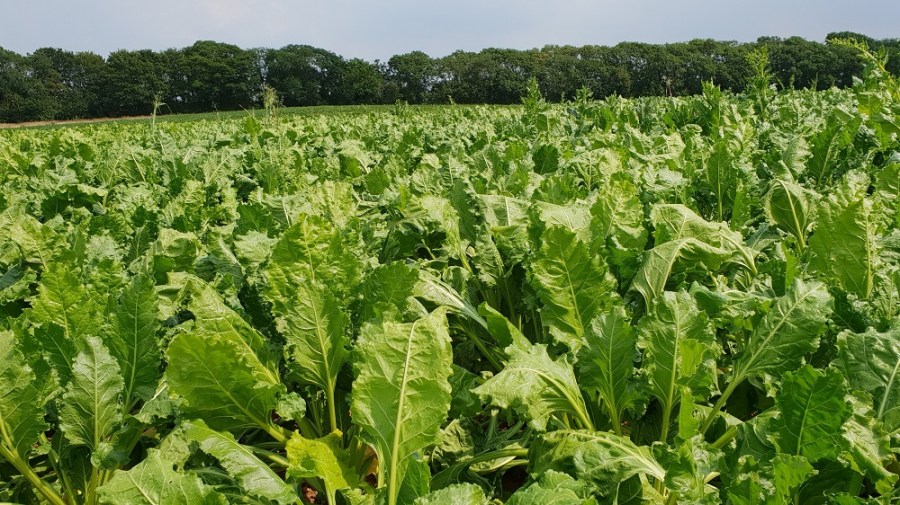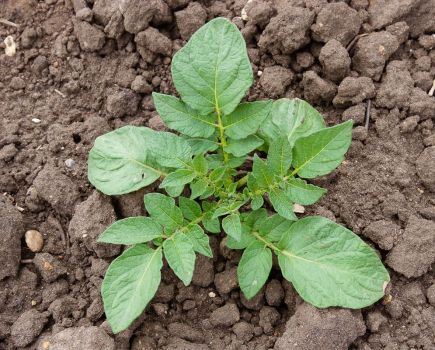In a recent briefing to AICC advisers, sugar beet breeder SESVanderhave looks at the challenges to sugar beet production and discusses what’s needed to help growers tackle them. CPM reports.
It’s really important growers have access to the seed treatment they need, on the variety they’ve selected.
By Lucy de la Pasture
This season the sugar beet clock has been reset by two decades. The loss of neonics has changed everything and this time around growers don’t have the same effective armoury of active chemistry to tackle their pest problems, comments Ian Munnery, managing director for SESVanderhave UK, as he addresses a group of AICC beet advisers at their office in Lincs.
That’s put the onus on sugar beet breeders to come up with a solution and all the breeding houses are working hard to find the genetic traits needed to give new varieties tolerance to pests, weeds and diseases. In fact SESVanderhave plough back 18% of their turnover into R&D, he adds.
“It’s not likely to be a single gene solution because virus yellows isn’t a simple disease, it’s made up of a complex of vector-borne viruses. Genetics on their own won’t solve the problem and nor will chemistry. The answer will be an integrated approach where crop management, varieties and chemistry all play a part,” believes Ian.
“We have tolerance traits in trials now, but it isn’t going to be as good as the neonics were in controlling the spread of virus. There will be a yield lag associated with it, at least initially and unwanted traits that we have to breed out – such as bolting. All of this will take time using conventional breeding techniques,” he adds.
The structure of the sugar beet industry in the UK poses a unique problem to growers and Ian believes there’s a stirring for change so that growers can reliably access the tools they need to do their job. It’s a view that was echoed by the AICC members present, many of whom had growers that had received different varieties to the ones they’d ordered and without the seed treatments that had been requested.
The NFU provide the interface between growers and British Sugar and Arable Alliance agronomist Andrew Wells, believes it’s time the NFU pressed the sugar processor on ‘the unsatisfactory situation we’ve endured for so long.’
“I understand that seed has probably also been a minor part of negotiations compared with trying to secure a fair contract for growers. But the days when seed was seed and the variety and treatment didn’t really matter are gone,” he says.
Norfolk agronomist Sue Lord agrees, saying that some growers had received standard treated seed when it had been ordered with Force (tefluthrin) to give some protection against soil pests. Clearly that puts the crop at a disadvantage from the word go, she says.
“Having been warned in a meeting by British Sugar staff to get orders in early, I got all my growers organised within days and they still didn’t get what we wanted, but other people you spoke to who ordered later had no problems.
“There was also little consultation about alternatives; the grower more or less gets told you can’t have X, we’re sending you Y and in one case the extra seed cost was quite substantial. In that case, the grower did question it and he got it changed. But the point is the lack of control the growers have over variety and seed dressings,” she explains.
There were other instances related where growers received a BCN tolerant variety where it hadn’t been ordered and BCN weren’t a problem. Another peculiarity of the season were apparent problems in the processing of the seed, which produced anomalies in the shape of seed pellets, with tear drops and ovals leading some growers to dig out old belt planters in order to get the seed in the ground because their more modern drills couldn’t cope with anything but round seed.
All agronomists expressed extreme frustration at the lack of Vibrance SB (sedaxane+ fludioxonil+ metalaxyl-m) treated seed. Its supply was restricted for 2019 and some varieties weren’t offered with the treatment at all.
“Vibrance treated was very expensive last year, more than the price Syngenta had believed it would be offered for, and with thiram going we’re going to need to gain experience using it,” says Andy.
Sue points out that the metalaxyl in Vibrance also has activity on downy mildew which could prove useful during establishment, especially as the crop now needs to reach the 12-leaf stage as soon as possible to help counter the threat of virus yellows.
“With no new seed treatments in the pipeline, it’s really important growers have access to the seed treatment they need on the variety they’ve selected,” agrees Ian.
Sugar beet specialist Dr Pat Turnbull, who sits on the RL Crops Committee, points out that all the seed used in the RL trials is unprimed and, from the 2019 sowing season, is treated with Vibrance SB plus tachygaren plus Force which is something else to bear in mind when viewing the data.
For the first time last year, untreated trials were included in the RL trials and it will help provide a better insight to the overall disease profile of varieties, believes Ian.
“Untreated yield data from 2018 harvest has just been made available (mid-July) and it’s a really important addition to the disease ratings given in the RL. These are created from leaf scores for an individual disease. In real life, diseases appear as a cocktail, infection from one can make the plant more vulnerable to infection from another so they can’t really be considered in isolation to get the full picture.
“Sugar beet is also a hybrid and I always give the analogy that it’s like a football team, with all the players that make it up. That means in any one variety each plant may express its parent’s traits in a slightly different way, which is another reason why you need to look at all the factors that have impacted on yield in a given year. Taken in isolation, a leaf disease, yield or bolting score can amount to a ‘hitch hiker’s guide to the galaxy’ of 42 if you’re not careful,” comments Ian.
Ian acknowledges that trials work is expensive to do but vital to validate performance for growers. “After all, the objective is to trial and test our breeding for UK growers’ conditions; not to breed for success in the trials,” he says.
The wider access to variety data is another question for the future. Ian passionately believes that growers should have as much information as possible to make their variety choices. “It’s the foundation of everyone’s crop, so it’s important time is spent engaging fully with the data that growers, industry and breeders have funded.
“For example the RL bolting data is available for the crops in the ground in Sept, disease data is available in Oct/Nov and yield data in Nov, but unlike in cereals and oilseeds where the data is published as soon as it’s available, growers aren’t given access until May 2020, when the RL for 2021 is published and after they’ve sown their next crop.
“Whilst it’s been done this way for many years, it doesn’t mean we shouldn’t review this given the quantum changes and emerging threats in our landscape,” comments Ian.
“It’s particularly important that growers have early access this year because it’s the first data when varieties have been grown without neonic seed treatments. That means decisions for 2020 are being based on a three-year average of data that may no longer be as relevant” he says.
“One of the problems with the current system is that the ordering of the seed has historically happened in Sept, months before the crop is planted. This makes responding to changing requirements for varieties or seed treatment from growers challenging,” he adds.
Taking a wider view, Ian says that food security doesn’t appear to be on the radar in Westminster or the EU. “This question wasn’t even asked of consumers in a ‘fear barometer’ study recently conducted by European Food Safety Agency (EFSA),” he says.
“While much of European sugar beet production is heavily subsidised by Member States, a very inconsistent approach is taken by different countries which distorts the market. In contrast UK growers are receiving £19.07/tonne without any additional area support over the BPS.”
The disparity in derogations given for the use of neonics in 2019 is expected to repeat itself next season, which further distorts the advantage some countries have over others, says Ian.
“As many as 15 sugar beet factories are expected to close in Europe over the next few years because they’re restructuring, which the UK did in 2005. But the sugar beet market remains stable and the crop continues to offer opportunities within rotations to help control problem weeds, such as blackgrass.
“Global sugar prices look set to increase, so we’re anticipating a good future for beet, but we need to be more dynamic in our anticipation and management of the pest, weed and disease threats to keep the UK sugar industry competitive and sustainable,” he says.
Untreated yield data for 2018 released
BBRO have published the 2018 untreated trial data to allow growers to see the results from the RL series of trials that were not treated with foliar fungicides. This work is in its first year and must be treated with caution, says BBRO.
“The table below shows data from the two replicated 2018 trials (untreated with foliar fungicides) where foliar diseases were assessed and the crop taken to yield to show the varietal performance under the natural cocktail of diseases. Rust and powdery mildew were the main diseases but others were present at low levels in some plots. It should be born in mind that each season is different with perhaps 2018 more so than most.
“Foliar diseases generally developed later than normal and on crops which had been through a period of considerable drought stress, which may or may not have influenced their susceptibility to diseases. Canopy growth patterns were certainly very unusual with considerable early leaf stress and senescence during the drought and then lots of regrowth in September. Canopy growth habits weren’t typical, and these may have influenced disease development.
“These results should be treated with great reserve as they apply only to the one year in which the trials were grown (2018). Considerable fluctuation in performance from centre to centre and similar fluctuations from season to season severely limit the value of results from a single year.”
Ian points out that when the yields for both untreated trials are averaged, four varieties from SESVanderhave feature in the top five. “It’s quite an achievement and illustrates the importance of building in resilience to a spectrum of diseases and growing conditions rather than considering them in isolation,” he concludes.





